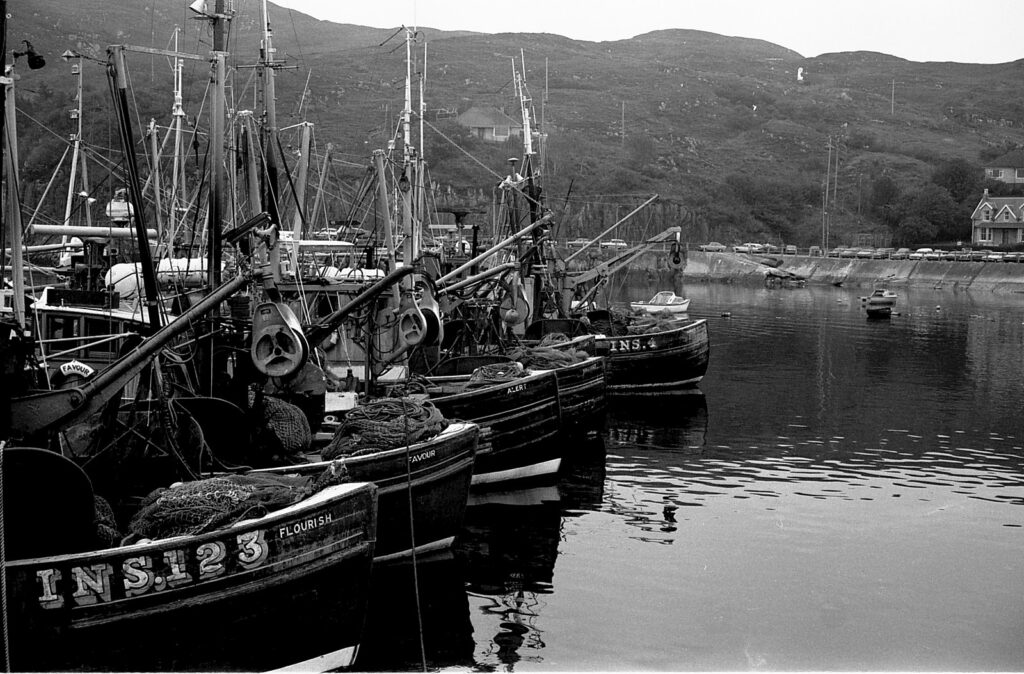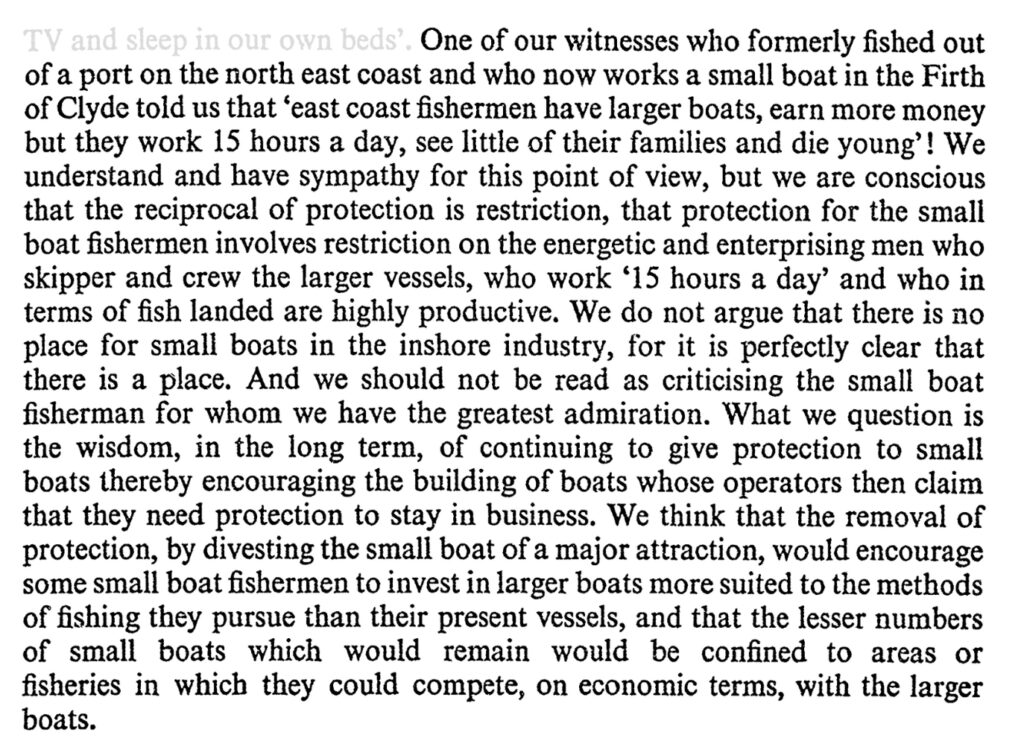Forty years ago today, decisions in Westminster profoundly changed the dynamics of Scotland’s coastal and fishing communities. At the stroke of a pen, Ministers passed legislation which removed a ban on bottom-trawling that had been in place for nearly 100 years. It has been described as one of the most disastrous decisions ever made in the history of our fisheries.
The decision opened inshore waters to more industrial and intensive fishing methods and had a devastating impact on many inshore fishermen who previously relied on nearshore fishing grounds. Historical records now show that this decision was the result of lobbying by larger commercial trawlers and a Westminster government that failed to protect and respect the socio-economic value of traditional inshore fishing that had supported coastal and crofting communities for decades.
Overfishing and damage to inshore fish nursery grounds led to fewer fish and fishermen in coastal seas. How did we get here? And what can we do to restore our fisheries? This blog takes a look at the historical reports from inshore fishermen calling for fishing grounds to be safeguarded which are just as relevant today as they were 40 years ago.
Fishing before 1984

For generations, Scottish inshore fishermen relied on the rich, nearshore waters for their livelihoods. Fishing was more than just an occupation; it was a way of life deeply embedded in the culture and historical roots of coastal communities. Small-scale fishermen, mostly operating boats less than 50 feet in length, were often the backbone of these communities, sustaining local economies and preserving traditions passed down through the centuries.
In the late 19th century, increased demand for fish led to the rise of more intensive and indiscriminate forms of fishing, such as steam-powered trawling. Fish populations began to decline and so, at the recommendation of local fishers and scientists, a “three mile limit” was established, making it illegal to use beam trawling or otter trawling within three miles of low water mark along the Scottish coast. The motivation behind this Herring Fishery (Scotland) Act of 1889 was twofold: to protect the traditional fishing methods that were less impactful and more sustainable, and to conserve fish stocks that were crucial for the local economy.
For decades, the three mile limit helped maintain productive inshore fisheries while fisheries outside the boundary continued to decline due to mismanagement and overexploitation. Understably, the trawling industry was eager to exploit rich inshore fisheries and lobies for access to these protected inshore waters.
The Cameron Report
The Regulation of Scottish Inshore Fisheries (also known as the ‘Cameron Report‘) was commissioned in December 1967 in response to growing concerns over the effectiveness and fairness of existing fishing regulations. The mandate was to review the law governing fishing in Scottish coastal waters, taking into account the changing patterns of sea fishing, the requirements of fishing communities, the conservation of fish populations, and the cost and method of enforcement. This was in the days before devolution, so it was commissioned by the then UK Government’s Department of Agriculture and Fisheries for Scotland and presented its findings to Westminster MPs in 1970.
The Cameron Report played a pivotal role in the eventual removal of the three-mile limit. The report highlighted various aspects of the fishing industry, weighing the interests of different stakeholders. However, it became evident that the removal of the limit was largely against the wishes of the small-scale fishing fleet.
According to the report, the small-scale fishermen expressed significant concerns over the removal of the three-mile limit, fearing that larger vessels would dominate the fishing grounds and jeopardise their livelihoods.
We were informed that the fishermen concerned came from crofting communities and that their methods were more suited than seining or trawling to the crofting way of life; that their communities were small, therefore the manning of larger, more sophisticated vessels ,would present a problem; that the age, lack of range, restricted fishing capability and size of their vessels were not important so long as the 3 mile limit remained; that the removal of the limit would jeopardise their livelihood and have a very serious effect on their communities; that there was no alternative employment.
Paragraph 189, page 97
The report acknowledged these fears but ultimately downplayed them. The report also writes off the value of small fishermen stating that the nephrops creel, small line and ground net fisheries operating within the three mile limit “are of very minor significance”. The bias towards large industrial trawlers in the report is brutally apparent. When detailing fisher’s concerns that trawling is destructive, they add “we doubt whether there is any real substance in this claim”; whereas, the arguments advanced by the trawling interests “seem to us to be in the main well founded and fairly stated”.
The report argues that the local small boats do not deserve protection because the small-scale local fishers are not as important as the larger, industrial fleet. Exploitation is in the nation’s best interest, and competition will bring the industry forward.

While these part-time fishers played a vital role to their local communities; the government saw little value in sustainable “for the pot” fishing compared to fishing for profit.

The view that removing the three mile limit would benefit the broader fishing community in the long run did not take into account the immediate and potentially severe impacts on small-scale fishermen. The structure of the local fleet had been significantly influenced by existing regulations. Many small-scale fishermen had invested heavily in their boats and gear based on the assurance that these protections would remain in place. The abrupt removal of these protections would force some fishermen out of the industry altogether.
Fishermen articulated this concern;
The industry on the east coast was built up under the protection of the prohibitions on trawling and seining within the 3 mile limit and of permissive byelaws, which in effect gave local small boat fishermen such priority. It would be a mistake, and unjust, to remove this protection from the north west coast just when, for the first time for many decades, there is a real possibility, which is being fostered by the Government and the [Highlands and Islands Development Board] of an expansion of locally-based fishing.
Paragraph 140(9), page 74
This sentiment was widespread among the small-scale fishing communities, who felt that their voices were not being adequately heard in the decision-making process. While the trawl boats were capable of fishing further offshore, many inshore creel, line, and ground net fishers needed the sheltered waters within the three-mile limit to operate safely and effectively.
Creel fishermen explained;
There has already been a considerable investment in nephrops creels and boats on the assumption that the 3 mile limit protection will continue in existence. By reason of their size and the nature of their gear most nephrops creel boats are confined to waters close to their home ports. If these grounds were ‘cleaned up’ by trawlers, the nephrops creel fishery would have to be abandoned.
Paragraph 140(10), page 74
If one thing is clear from the Cameron report, it’s that the government knew that local fishing communities were against removing the three mile limit, yet their knowledge and opinions were disregarded in favour of a more industrial and centralised fishing industry.

Removal of the three mile limit
On June 26th, 1984 the legislation was passed to repeal the three mile limit, coming into effect a year later. For small-scale fishermen, the abrupt removal of the three mile limit was more than just a regulatory change; it was a fundamental shift that profoundly affected their way of life and the condition of Scotland’s inshore waters. Some have experienced the removal of the three mile limit as having a major impact on their coastal communities, with echoes of the Highlands Clearances two centuries before. Time has shown that the concerns expressed by these fishers in the Cameron Report were valid, and that many of the scientific, social, and economic assumptions made in the report were inherently flawed. Today, many of Scotland’s seabed habitats are damaged or destroyed, with inshore stocks of fish species such as herring, cod, haddock, hake, turbot, saithe, whiting, plaice and flounder reaching commercial extinction.
Today the government claims to support Scotland’s coastal communities, and yet the agenda – so apparent in the Cameron report – to support ‘big fishing’ at the expense of inshore boats, still pervades politics to this very day. Many Scottish Government policies appear to favour and subsidise industrial trawlers, multinational salmon farm operations and large-scale offshore wind projects, often to the detriment of the inshore, small-scale fishing businesses that have survived the last forty years of deregulation.
Coastal communities today
The Our Seas coalition has been gathering testimonies from people all around Scotland to learn about their first-hand experiences and perspectives on the management of Scotland’s inshore seas. These ‘Coastal Testimonies’ will be toured throughout Scotland in order to amplify historically marginalised voices from our coastal communities and inspire fisheries management that considers the diverse needs and impacts on all stakeholders involved.

The removal of the three mile limit had a devastating effect on fishing communities on the West Coast. I think there should be restrictions on where we can trawl and dredge. It seems obvious to me that static gear does a lot less damage than mobile gear. The West Coast has always had a history of small-scale fishing. I feel that if it had been left like that we’d still have plentiful fish stocks and plentiful shellfish stocks on the West Coast. I think a lot of us in the static sector have actually given up somewhat, because we hope things are gonna get better. We hope for some protection, we hope for all this kind of thing. And that’s just not happened. So nearly 40 years down the line after the removal of the three mile limit. What protection has come in for inshore stocks or inshore fishermen? Not only are the fish a dying breed, so are the fishermen, unfortunately. And I believe that fishing is an integral part of the West Coast life. The whole West Coast lifestyle is changing. This is something that should be a thriving, booming industry and it’s not. Unless we do something about it very soon, it’ll just be another niche heritage kind of thing that we’ll be talking about us that has gone like so many other industries
Ian McWhinney, fisherman, Badachro
The Our Seas Coalition
Today, there is a chance to right some of the wrongs of the past and manage Scotland’s fisheries in a way which puts environmental sustainability as the foundation for resilient national economic and local development strategies. The Our Seas coalition is an alliance of 140 coastal businesses, community groups, fishermen’s associations and environmental organisations campaigning for the environmental recovery of Scotland’s coastal marine environment and the revival of sustainable inshore fisheries. We are calling for
- The return of a modern inshore limit* on bottom-towed fishing, via a just transition.
- Effective vessel tracking systems for all boats.
- Preferential allocation of fishing opportunity to vessels that have a low environmental impact and which bring increased sustainable economic value and employment to communities.
Take action today to safeguard Scotland’s coastal seas, small scale fishing and coastal communities.
*We are advocating for a modern inshore limit, which would create a fisheries management system based on a presumption against environmental damage and safeguard the low impact fishing that remains. Within this inshore limit bottom-towed fishing gear would only be licensed in areas where it can be ecologically and socially justified as an alternative to creeling, diving or other low impact fishing methods. Sensitive areas beyond this inshore limit must be afforded protection via a properly funded and policed MPA network and additional fisheries management measures. This would allow for flexibility around the coast that takes into account local seabed conditions and the variation in fisheries in the different marine regions.
It’s time for positive change!